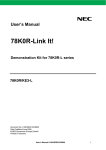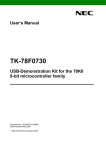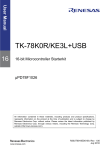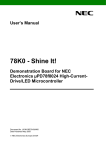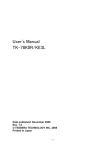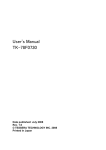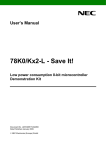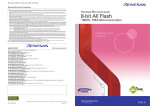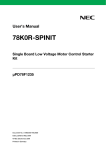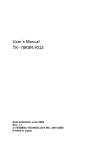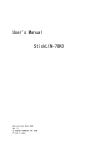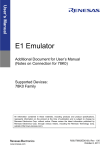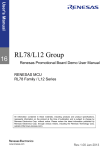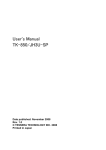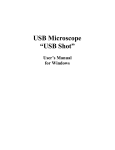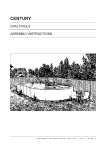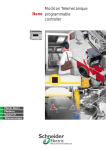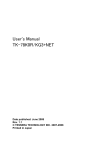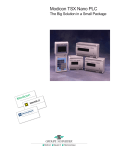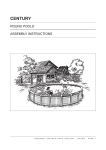Download User`s Manual 78K0R- Save It!
Transcript
User’s Manual 78K0R - Save It! Demonstration Kit Document No. U19663EE1V0UM00 Date Published January 2009 © NEC Electronics (Europe) GmbH 78K0R – Save It! • The information in this document is current as of June, 2008. The information is subject to change without notice. For actual design-in, refer to the latest publications of NEC Electronics data sheets or data books, etc., for the most up-to-date specifications of NEC Electronics products. Not all products and/or types are available in every country. Please check with an NEC Electronics sales representative for availability and additional information. • No part of this document may be copied or reproduced in any form or by any means without the prior written consent of NEC Electronics. NEC Electronics assumes no responsibility for any errors that may appear in this document. • NEC Electronics does not assume any liability for infringement of patents, copyrights or other intellectual property rights of third parties by or arising from the use of NEC Electronics products listed in this document or any other liability arising from the use of such products. No license, express, implied or otherwise, is granted under any patents, copyrights or other intellectual property rights of NEC Electronics or others. • Descriptions of circuits, software and other related information in this document are provided for illustrative purposes in semiconductor product operation and application examples. The incorporation of these circuits, software and information in the design of a customer's equipment shall be done under the full responsibility of the customer. NEC Electronics assumes no responsibility for any losses incurred by customers or third parties arising from the use of these circuits, software and information. • While NEC Electronics endeavors to enhance the quality, reliability and safety of NEC Electronics products, customers agree and acknowledge that the possibility of defects thereof cannot be eliminated entirely. To minimize risks of damage to property or injury (including death) to persons arising from defects in NEC Electronics products, customers must incorporate sufficient safety measures in their design, such as redundancy, fire-containment and anti-failure features. • NEC Electronics products are classified into the following three quality grades: "Standard", "Special" and "Specific". The "Specific" quality grade applies only to NEC Electronics products developed based on a customerdesignated "quality assurance program" for a specific application. The recommended applications of an NEC Electronics product depend on its quality grade, as indicated below. Customers must check the quality grade of each NEC Electronics product before using it in a particular application. "Standard": Computers, office equipment, communications equipment, test and measurement equipment, audio and visual equipment, home electronic appliances, machine tools, personal electronic equipment and industrial robots. "Special": Transportation equipment (automobiles, trains, ships, etc.), traffic control systems, anti-disaster systems, anti-crime systems, safety equipment and medical equipment (not specifically designed for life support). "Specific": Aircraft, aerospace equipment, submersible repeaters, nuclear reactor control systems, life support systems and medical equipment for life support, etc. The quality grade of NEC Electronics products is "Standard" unless otherwise expressly specified in NEC Electronics data sheets or data books, etc. If customers wish to use NEC Electronics products in applications not intended by NEC Electronics, they must contact an NEC Electronics sales representative in advance to determine NEC Electronics' willingness to support a given application. (Note) (1) "NEC Electronics" as used in this statement means NEC Electronics Corporation and also includes its majority-owned subsidiaries. (2) "NEC Electronics products" means any product developed or manufactured by or for NEC Electronics (as defined above). M8E 02. 11-1 _______________________________________________________________________________________________ User’s Manual U19663EE1V0UM00 2 78K0R – Save It! CAUTION This is a Test- and Measurement equipment with possibility to be significantly altered by user through hardware enhancements/modifications and/or test or application software. Thus, with respect to Council Directive 89/336/EEC (Directive on compliance with the EMC protection requirements), this equipment has no autonomous function. Consequently this equipment is not marked by the CE-symbol. EEDT-ST-005-10 CAUTION This equipment should be handled like a CMOS semiconductor device. The user must take all precautions to avoid build-up of static electricity while working with this equipment. All test and measurement tool including the workbench must be grounded. The user/operator must be grounded using the wrist strap. The connectors and/or device pins should not be touched with bare hands. EEDT-ST-004-10 For customers in the European Union only Redemption of Waste Electrical and Electronic Equipment (WEEE) in accordance with legal regulations applicable in the European Union only: This equipment (including all accessories) is not intended for household use. After use the equipment cannot be disposed of as household waste. NEC Electronics (Europe) GmbH offers to take back the equipment. All you need to do is register at http://www.eu.necel.com/weee _______________________________________________________________________________________________ User’s Manual U19663EE1V0UM00 3 78K0R – Save It! Regional Information Some information contained in this document may vary from country to country. Before using any NEC product in your application, please contact the NEC office in your country to obtain a list of authorized representatives and distributors. They will verify: • • • • • • Device availability Ordering information Product release schedule Availability of related technical literature Development environment specifications (for example, specifications for third-party tools and components, host computers, power plugs, AC supply voltages, and so forth) Network requirements In addition, trademarks, registered trademarks, export restrictions, and other legal issues may also vary from country to country. NEC Electronics Inc. (U.S.) Santa Clara, California Tel: 408-588-6000 800-366-9782 Fax: 408-588-6130 800-729-9288 NEC Electronics Hong Kong Ltd. Hong Kong Tel: 2886-9318 Fax: 2886-9022/9044 NEC Electronics (Europe) GmbH Duesseldorf, Germany Tel: 0211-65 03 0 Fax: 0211-65 03 1327 NEC Electronics Hong Kong Ltd. Seoul Branch Seoul, Korea Tel: 02-528-0303 Fax: 02-528-4411 Sucursal en España Madrid, Spain Tel: 091- 504 27 87 Fax: 091- 504 28 60 NEC Electronics Singapore Pte. Ltd. Singapore Tel: 65-6253-8311 Fax: 65-6250-3583 Succursale Française Vélizy-Villacoublay, France Tel: 01-30-67 58 00 Fax: 01-30-67 58 99 NEC Electronics Taiwan Ltd. Taipei, Taiwan Tel: 02-2719-2377 Fax: 02-2719-5951 Filiale Italiana Milano, Italy Tel: 02-66 75 41 Fax: 02-66 75 42 99 NEC do Brasil S.A. Electron Devices Division Guarulhos, Brasil Tel: 55-11-6465-6810 Fax: 55-11-6465-6829 Branch The Netherlands Eindhoven, The Netherlands Tel: 040-244 58 45 Fax: 040-244 45 80 Branch Sweden Taeby, Sweden Tel: 08-63 80 820 Fax: 08-63 80 388 United Kingdom Branch Milton Keynes, UK Tel: 01908-691-133 Fax: 01908-670-290 _______________________________________________________________________________________________ User’s Manual U19663EE1V0UM00 4 78K0R – Save It! Revision History Date 2009-03-16 Revision V1.00 Chapter --- Description First release _______________________________________________________________________________________________ User’s Manual U19663EE1V0UM00 5 78K0R – Save It! Table of Contents 1. Introduction ............................................................................................................................ 10 1.1 1.2 1.3 1.4 Package contents................................................................................................................................. 10 Features ................................................................................................................................................ 10 System requirements........................................................................................................................... 11 Trademarks ........................................................................................................................................... 11 2. 78K0R – Save It! Components .............................................................................................. 12 2.1 Operation mode settings..................................................................................................................... 12 2.2 SW1........................................................................................................................................................ 12 2.3 SW2........................................................................................................................................................ 13 2.4 SW3........................................................................................................................................................ 13 2.5 SW4 (Reset switch) .............................................................................................................................. 13 2.6 SW5 (INTP0) .......................................................................................................................................... 13 2.7 SW6 (INTP2) .......................................................................................................................................... 13 2.8 JP1 ......................................................................................................................................................... 14 2.9 JP2 ......................................................................................................................................................... 14 2.10 Q4 (illuminance sensor) .................................................................................................................... 14 2.11 U10, U12 (7 segment LED)................................................................................................................. 14 2.12 LED1 (power LED).............................................................................................................................. 15 2.13 Universal area..................................................................................................................................... 15 2.13.1 Minicube2 connector ......................................................................................................................... 15 3. 78K0R – Save It! system configuration................................................................................ 17 3.1 3.2 3.3 78K0R – Save It! ................................................................................................................................... 17 Host computer ...................................................................................................................................... 17 Power supply via USB interface ......................................................................................................... 17 4. 78K0R – Save It! installation and operation ........................................................................ 18 4.1 4.2 Getting started...................................................................................................................................... 18 CD-ROM contents ................................................................................................................................ 18 5. Hardware installation............................................................................................................. 19 6. Software installation.............................................................................................................. 20 6.1 6.2 6.3 6.4 6.5 6.6 6.6.1 6.6.2 6.7 TK-78K0RKE3L demonstration program installation....................................................................... 20 IAR Systems Embedded Workbench for 78K installation ............................................................... 21 IAR Systems visualSTATE Installation .............................................................................................. 22 Device file package of 78K0R/Kx3-L for IAR Embedded Workbench installation......................... 22 WriteEZ4 installation............................................................................................................................ 22 USB Driver Installation ........................................................................................................................ 22 Installation on Windows 2000 ............................................................................................................. 22 Installation on Windows XP................................................................................................................. 26 Confirmation of USB Driver Installation ............................................................................................ 29 _______________________________________________________________________________________________ User’s Manual U19663EE1V0UM00 6 78K0R – Save It! 7. Demo application using the TK-78K0R/KE3L demonstration program ............................ 30 8. Applilet EZ PL......................................................................................................................... 31 8.1 8.2 8.3 Overview ............................................................................................................................................... 31 Features ................................................................................................................................................ 31 Applilet EZ PL demo application ........................................................................................................ 32 9. Flash Programmer WriteEZ4................................................................................................. 33 9.1 9.2 Device Setup......................................................................................................................................... 33 Using WriteEZ4..................................................................................................................................... 34 10. Erasing the flash memory (using the WriteEZ4) ............................................................... 35 11. IAR Embedded Workbench 78K0R – Save It! sample project ......................................... 36 11.1 Hardware setup .................................................................................................................................. 36 11.2 Loading the Save It! sample project ................................................................................................ 36 11.3 Running the application .................................................................................................................... 41 11.3.1 Count mode....................................................................................................................................... 41 11.3.2 Blink mode......................................................................................................................................... 42 11.3.3 Spinning mode .................................................................................................................................. 42 12. IAR visualSTATE 78K0R – Save It! sample project .......................................................... 43 12.1 12.2 12.3 12.4 Hardware setup .................................................................................................................................. 43 Functionality of the sample project ................................................................................................. 43 Running the sample project.............................................................................................................. 44 Debug the 78K0R – Save It! visualSTATE sample project............................................................. 46 13. Cables ................................................................................................................................... 47 13.1 USB interface cable (Mini-B type) .................................................................................................... 47 14. Schematics ........................................................................................................................... 48 _______________________________________________________________________________________________ User’s Manual U19663EE1V0UM00 7 78K0R – Save It! List of Figures Figure 1: 78K0R – Save It! components .....................................................................................................12 Figure 2: 78K0R – Save It! 7 segment LEDs structure ...............................................................................15 Figure 3: 78K0R – Save It! 7 segment LED port pin connection ................................................................15 Figure 4: 78K0R – Save It! MiniCube2 connector.......................................................................................16 Figure 5: 78K0R – Save It! Minicube2 connection solder bridges ..............................................................16 Figure 6: 78K0R- Save It! system configuration..........................................................................................17 Figure 7: 78K0R – Save It! CD-ROM contents ...........................................................................................18 Figure 8: 78K0R – Save It! CRROM autorun.exe .......................................................................................20 Figure 9: IAR Systems Installation screen ..................................................................................................21 Figure 10: Found New Hardware Wizard (Windows 2000).........................................................................23 Figure 11: Search Method (Windows 2000)................................................................................................23 Figure 12: Driver File Location (Windows 2000) .........................................................................................24 Figure 13: Address Specification 1 (Windows 2000) ..................................................................................24 Figure 14: Address Specification 2 (Windows 2000) ..................................................................................25 Figure 15: Address Specification 3 (Windows 2000) ..................................................................................25 Figure 16: Driver File Search (Windows 2000) ...........................................................................................25 Figure 17: USB Driver Installation Completion (Windows 2000) ................................................................26 Figure 18: Found New Hardware Wizard 1 (Windows XP).........................................................................26 Figure 19: Found New Hardware Wizard 2 (Windows XP).........................................................................27 Figure 20: Search Location Specification 1 (Windows XP).........................................................................27 Figure 21: Search Location Specification 2 (Windows XP).........................................................................28 Figure 22: Windows XP Logo Testing (Windows XP) .................................................................................28 Figure 23: USB Driver Installation Completion (Windows XP)....................................................................29 Figure 24: Windows Device Manager .........................................................................................................29 Figure 25: TK-78K0RKE3L demonstration program ...................................................................................30 Figure 26: Applilet EZ PL main window.......................................................................................................31 Figure 27: WriteEZ4 Startup.......................................................................................................................33 Figure 28: WriteEZ4 Device Setup Dialogue ..............................................................................................33 Figure 29: WriteEZ4 Device Menu ..............................................................................................................34 Figure 30: WriteEZ4 open .prm file .............................................................................................................35 Figure 31: WriteEZ4 flash erase successful................................................................................................35 Figure 32: IAR Embedded Workbench Startup window..............................................................................36 Figure 33: IAR Embedded Workbench Main IDE window ..........................................................................37 Figure 34: IAR Embedded Workbench Debugger Options .........................................................................38 Figure 35: Embedded Workbench Linker Configuration .............................................................................39 Figure 36: IAR Embedded Workbench MINICUBE2 settings .....................................................................40 Figure 37: IAR C-SPY debugger .................................................................................................................41 Figure 38: IAR visualSTATE navigator........................................................................................................44 Figure 39: IAR visualSTATE designer.........................................................................................................45 Figure 40: IAR Embedded Workbench visualSTATE sample project .........................................................46 Figure 41: USB interface cable (Mini-B type)..............................................................................................47 Figure 42: TK-78K0RKE3L schematics 1/3 ................................................................................................49 Figure 43: TK-78K0RKE3L schematics 2/3 ................................................................................................50 Figure 44: TK-78K0RKE3L schematics 3/3 ................................................................................................51 _______________________________________________________________________________________________ User’s Manual U19663EE1V0UM00 8 78K0R – Save It! List of Tables Table 1: 78K0R – Save It! Switch and Jumper settings ..............................................................................12 Table 2: SW1 modes ...................................................................................................................................13 Table 3: SW2 modes ...................................................................................................................................13 Table 4: SW3 modes ...................................................................................................................................13 Table 5: JP1 settings ...................................................................................................................................14 Table 6: JP2 settings ...................................................................................................................................14 Table 7: 7 segment LED port values ...........................................................................................................15 Table 8: Applilet EZ PL demo Switch settings ............................................................................................32 Table 9: WriteEZ4 action buttons ................................................................................................................34 Table 10: IAR EWB 78K0R – Save It! sample project hardware setup ......................................................36 Table 11: IAR VS 78K0R – Save It! sample project hardware setup..........................................................43 _______________________________________________________________________________________________ User’s Manual U19663EE1V0UM00 9 78K0R – Save It! 1. Introduction The 78K0R - Save It! demonstration Kit shows the system development possibilities using a NEC low power consumption microcontroller of the 78K0R/Kx3-L microcontroller family. A preprogrammed sample project, which is written to work with the TK-78K0R demo PC graphical user interface, provided on the CD-ROM, shows the current consumption in the different operating modes of the micro-controller. Furthermore an IAR Embedded Workbench for 78K, IAR visualSTATE and Applilet EZ PL sample projects for the 78K0R/Kx3-L can be found on the CD-ROM. 1.1 Package contents • TK-78K0R/KE3L board • USB cable • CD-ROM containing the TK78K0R/KE3L GUI, Applilet EZ PL, an evaluation copy of the IAR Embedded Workbench for 78K with 4Kbyte code size limitation and IAR visualSTATE Please verify that you have received all parts listed in the package contents list attached to the 78K0R Save It! demonstration kit package. If any part is missing or seems to be damaged, please contact the dealer from whom you received your 78K0R - Save It!. 1.2 Features • NEC Electronics µPD78F1009 low power consumption general purpose NEC 16-bit 78K0R MCU • NEC Electronics µPD78F0730 MCU with on-chip USB interface • 2 latched 7 segment LEDs • Low current consumption modes demo application with GUI for the Host PC • Applilet EZ PL graphical based, logic expression design tool, that directly creates the regarding object code • On-Board debug function (TK-78K0 debugging) The 78K0R Save It! supports an On-Board debug function by using the IAR C-SPY debugger without a need of additional debug hardware. It allows FLASH downloading and standard debug functions like code execution, single stepping, breakpoints, memory manipulation etc. • Power supply by USB interface or via external power supply • The IAR Embedded Workbench for 78K and the IAR C-SPY debugger / simulator are included. These packages are restricted in such that maximum program code size is limited to 4 Kbyte. • IAR visualSTATE demo, a package of integrated tools for developing, testing, and implementing embedded applications based on state chart diagrams. • Full documentation is included for the NEC 78K078F1009 microcontroller, NEC 78K0 78F0730 microcontroller, IAR Systems Embedded Workbench and IAR Systems C-SPY debugger / simulator. The 78K0R – Save It! is not intended for code development. NEC does not allow and does not support in any way any attempt to use 78K0R – Save It! in a commercial or technical product. _______________________________________________________________________________________________ User’s Manual U19663EE1V0UM00 10 78K0R – Save It! 1.3 System requirements HOST PC Host interface Note: A PC supporting Windows 2000, Windows XP or Windows Vista is required for the IAR Systems Embedded Workbench demo-version. A Pentium processor with at least 1 GHz CPU performance, with at least 256 Mbytes of RAM, allowing you to fully utilize and take advantage of the product features. 500 Mbytes of free disk space and an additional 10 Mbytes of free disk space on the Windows system drive. A web browser and Adobe Acrobat Reader to be able to access all the product documentation. USB interface that enables communication based on USB (Ver1.1 or later) Updates of the IAR Embedded Workbench for 78K, documentation and/or utilities for 78K0R SAVE IT!, if available, may be downloaded from the NEC WEB page(s) at http://www.eu.necel.com/78K0RSAVEIT 1.4 Trademarks IAR Embedded Workbench, visualSTATE and C-SPY are registered trademarks of IAR Systems AB. Microsoft and Windows are registered trademarks of Microsoft Corporation. Adobe and Acrobat Reader are registered trademarks of Adobe Systems Incorporated. All other product names are trademarks or registered trademarks of their respective owners. _______________________________________________________________________________________________ User’s Manual U19663EE1V0UM00 11 78K0R – Save It! 2. 78K0R – Save It! Components The TK-78K0R/KE3L board is equipped with USB-connector and with several connectors in order to be connected to host computers, FLASH programmer, MiniCube2 or any external target hardware. Figure 1: 78K0R – Save It! components 2.1 Operation mode settings Caused by the different operating modes the 78K0R –Save It! supports different switches and jumpers are available on the board. The table below shows the 3 different modes and the regarding switch / jumper setting for each mode. Switch / Jumper SW1 SW2 SW3.1 – SW3.3 SW3.4 – SW3.8 JP1 JP2 Demonstration mode DEMO DEMO OFF Unused Short 1-2 and 3-4 shorted Debugging / Writing mode Debug EXT ON Any Short 1-3 shorted PC communication mode K0USB K0USB OFF Any Short 1-3 shorted Table 1: 78K0R – Save It! Switch and Jumper settings 2.2 SW1 SW1 is a 3 position switch to set following modes. _______________________________________________________________________________________________ User’s Manual U19663EE1V0UM00 12 78K0R – Save It! Position Left middle Right Mode Demo K0USB Debug Table 2: SW1 modes 2.3 SW2 SW2 is a 3 position switch to set following modes. Position Left middle Right Mode Demo K0USB EXT Table 3: SW2 modes 2.4 SW3 SW3 is an 8 position DIP switch with following functions Bit 1 2 3 4 5 6 7 8 Mode Mode selection (see Table 1) Mode selection (see Table 1) Mode selection (see Table 1) Connected to microcontroller port pin P33 Connected to microcontroller port pin P42 Connected to microcontroller port pin P43 Connected to microcontroller port pin P77 Connected to microcontroller port pin P76 Table 4: SW3 modes Note: Make sure to set the regarding pull-up resistor option registers (PUx) of the microcontroller if the Pins P33, P42, P43, P76 and P77. Please refer to the device user’s manual of the 78K0R/Kx3-L for detailed information about the pull-up resistor option register settings. 2.5 SW4 (Reset switch) SW4 is connected to the external reset pin of the µPD78F1009 microcontroller. External reset can be triggered by pushing. 2.6 SW5 (INTP0) SW5 is connected to the "P120/INTP0/EXLVI" pin of the µPD78F1009 microcontroller. It can be used as external interrupt source. Note: Make sure to set up the microcontroller internal pull-up resistor option register (PU12) correctly when using this external switch. Please refer to the device user’s manual of the 78K0R/Kx3-L for detailed information about the pull-up resistor option register settings. 2.7 SW6 (INTP2) _______________________________________________________________________________________________ User’s Manual U19663EE1V0UM00 13 78K0R – Save It! SW6 is connected to the "P32/SCK10/SCL10/INTP2" pin of the µPD78F1009 microcontroller. It can be used as external interrupt source. Note: Make sure to set up the microcontroller internal pull-up resistor option register (PU12) correctly when using this external switch. Please refer to the device user’s manual of the 78K0R/Kx3-L for detailed information about the pull-up resistor option register settings. 2.8 JP1 JP1 is a switch jumper to select the power supply. Position Short Open Function USB power supply connected (USB1) Power supply via CN1 or CN2 Table 5: JP1 settings 2.9 JP2 JP2 is a jumper field to establish a current consumption measurement Jumper settings 1-2 and 3-4 short 1-3 short any other setting Demonstration mode Debugging/Writing and PC communication mode restricted Table 6: JP2 settings 2.10 Q4 (illuminance sensor) The illuminance sensor Q4 is connected to the P80/CMP0P/INTP3/PGAI pin of the µPD78F1009 microcontroller. When lightening up the voltage gains up and when darkening it goes down. So the gain amplifier function of the microcontroller can be used to read the illuminance. For further information to set up the registers of the microcontroller to use the gain amplifier functionality please refer to the device user’s manual. 2.11 U10, U12 (7 segment LED) U10 and U12 are two 7 segment LEDs. They can be set through the latches U11 and U13. The data channels of the latch are connected to channel P20 to P27 and the clock pins to P00 (U10) and P01 (U12) of the of the µPD78F1009 microcontroller. _______________________________________________________________________________________________ User’s Manual U19663EE1V0UM00 14 78K0R – Save It! Figure 2: 78K0R – Save It! 7 segment LEDs structure Figure 3: 78K0R – Save It! 7 segment LED port pin connection In respect to the pin connection the following table shows the port values to be written to show the numbers from 0 to 9 on the 7 segment LEDs. Digital number 0 1 2 3 4 Port value (hex) 0xC0 0xF9 0xA4 0xB0 0x99 Digital number 5 6 7 8 9 Port value (hex) 0x92 0x83 0xF8 0x80 0x98 Table 7: 7 segment LED port values 2.12 LED1 (power LED) LED1 is the power LED, lights up when power is supplied via USB, CN1 or CN2 to the 78K0R – Save It! 2.13 Universal area The Universal area of the 78K0R – Save It! is a free for the customer to use mounting area. Furthermore there is the possibility to mount a MiniCube2 connector to the Universal area 2.13.1 Minicube2 connector If a MiniCube2 shall be connected to the 78K0R – Save It! starter kit a 16-pin connector has to be mounted to the universal area as shown below. _______________________________________________________________________________________________ User’s Manual U19663EE1V0UM00 15 78K0R – Save It! Figure 4: 78K0R – Save It! MiniCube2 connector Furthermore some solder bridges have to be shorted to connect the connector to the target device. Figure 5: 78K0R – Save It! Minicube2 connection solder bridges _______________________________________________________________________________________________ User’s Manual U19663EE1V0UM00 16 78K0R – Save It! 3. 78K0R – Save It! system configuration The 78K0R – Save It! starter kit system configuration is given in the diagram below Figure 6: 78K0R- Save It! system configuration 3.1 78K0R – Save It! The 78K0R – Save It! is a demonstration kit for the 78F1009 16-bit low power consumption microcontroller of the 78K0R family. The demonstration board is connected to the host system via USB interface cable. The host system may be used for On-Chip debugging by using the IAR C-SPY debugger and to allow execution of application programs on 78K0R – Save It! starter kit. 78K0R – Save It! runs the microcontroller at 20 MHz operating speed in normal operation mode. 3.2 Host computer The USB host interface enables communication to the 78K0R – Save It! board. The μPD78F0730 78K0 8Bit microcontroller with on-chip USB interface and the NEC virtual UART driver allows application software to access the µPD78F1009 device in the same way as it would access a standard RS232 interface. The NEC virtual UART driver appears to the windows system as an extra Com Port, in addition to any existing hardware Com Ports. 3.3 Power supply via USB interface The TK-78F0730 board is powered by the USB interface. Optional the power supply can be applied via a JACK connector which has to be mounted to CN3. _______________________________________________________________________________________________ User’s Manual U19663EE1V0UM00 17 78K0R – Save It! 4. 78K0R – Save It! installation and operation 4.1 Getting started The 78K0R – Save It! is delivered with two PC based user programs. The TK-78K0RKE3L demonstration program is designed to measure the current consumption, the CPU frequency and the actual illuminance (measured by an illuminance sensor). The Applilet EZ PL is an easy to use GUI based program to build up small logical circuits which are automatically converted into an IAR Embedded workbench or NEC PM+ project. They can be compiled and downloaded to the target hardware directly from within the Applilet EZ PL; therefore it is necessary that the chosen Workbench Suite is correctly installed on the Host PC. 4.2 CD-ROM contents CD-ROM ROOT - Acrobat Reader for 32Bit Windows OS 78K0R - Save It! Acrobat Applilet - Applilet EZ PL Device file package - µPD78F8024 Device file package Doc - Documentation dotnet - Microsoft .NET package Driver - TK-78K0RKE3L driver files IAR Systems - IAR Embedded Workbench for 78K IAR visualSTATE samples - Example projects for the 78K0R - Save It! Starter Kit TK-78K0R_KE3L_Demo - TK-78K0RKE3L current consumption demonstration program WriteEZ4 - Flash Programmer WriteEZ4 incl. PRM file for µPD78F1009 Figure 7: 78K0R – Save It! CD-ROM contents _______________________________________________________________________________________________ User’s Manual U19663EE1V0UM00 18 78K0R – Save It! 5. Hardware installation After unpacking the 78K0R – Save It! demonstration kit, connect the board via connector CN1 to your host computer using the provided USB interface cable. When TK-78K0R/KE3L board is connected, the USB driver needs to be installed on the host machine. Please refer to the following USB Driver Installation. _______________________________________________________________________________________________ User’s Manual U19663EE1V0UM00 19 78K0R – Save It! 6. Software installation The 78K0R – Save It! package comes with the following software packages: • TK-78K0R/KE3L demonstration program • IAR Systems Embedded Workbench for 78K 4Kbyte code size limited, including C compiler, assembler, linker, librarian and IAR C-SPY debugger / simulator • IAR Systems Visual State time limited demo program • Device file package of μPD78F1009 for IAR Embedded Workbench for 78K • WriteEZ4 flash programmer software including the PRM file for μPD78F1009 Figure 8: 78K0R – Save It! CRROM autorun.exe 6.1 TK-78K0RKE3L demonstration program installation Before the TK-78K0RKE3L demonstration program can be installed on the host PC it is mandatory that the .NET Framework is installed on the host PC. For further information about installing .NET Framework please refer to the TK-78K0R_DEMO_GUI.pdf available on the CD delivered with the 78K0R – Save It! package in the “\Doc” folder. _______________________________________________________________________________________________ User’s Manual U19663EE1V0UM00 20 78K0R – Save It! To install the TK-78K0RKE3L demonstration program just press the regarding button from the Autorun of the CD-ROM provided within the 78K0R – Save it! package. The setup dialogues will guide you through the installation process. The installation can also be started by executing the TK-78K0R_KE3L_Demo.msi in the directory “\TK-78K0R_KE3L Demo” of the CDROM. 6.2 IAR Systems Embedded Workbench for 78K installation To install the IAR Systems Embedded Workbench for 78K including C-SPY debugger / simulator press the regarding button from the Autorun of the CDROM provided within the 78K0R – Save It! package. The installation can also be started by executing the Autorun.exe program in the directory ”\IAR Systems\” of the CDROM. When running the autorun.exe the following screen appears. Figure 9: IAR Systems Installation screen To install the IAR Embedded Workbench for 78K just press the regarding button “Install IAR Embedded Workbench ®”. The setup dialogues will guide you through the installation process. For further information about the IAR Embedded Workbench installation refer to the InstallationGuide_IAR_EWB.ENU.pdf in the directory ”\IAR Systems\” of the CDROM. Note: Please make sure to install the 78K0R/Kx3-L device file package for the IAR Embedded Workbench, as explained below, before using the IAR Embedded Workbench with the TK78K0RKE3L board. _______________________________________________________________________________________________ User’s Manual U19663EE1V0UM00 21 78K0R – Save It! 6.3 IAR Systems visualSTATE Installation To install the IAR Systems visualSTATE press the regarding button from the Autorun of the CDROM provided within the 78K0R – Save It! package. The installation can also be started by executing the Autorun.exe program in the directory ”\IAR Systems\” of the CDROM. The IAR Systems Installation screen will appear and the installation of IAR visualSTATE can be started by pressing the “Install visualSTATE ®” button. The setup dialogues will guide you through the installation process. For further information about the IAR visualSTATE installation refer to the “InstallationGuide_IAR_VS.ENU.pdf” in the directory ”\IAR Systems\” of the CDROM. 6.4 Device file package of 78K0R/Kx3-L for IAR Embedded Workbench installation To install the device file package of the 78K0R/Kx3-L for the IAR Embedded Workbench just press the regarding button from the Autorun of the CD-ROM provided within the 78K0R – Save It! package. The setup dialogues will guide you through the installation process. The installation can also be started by executing the dev_install.exe in the directory ”\Device file package” of the CDROM. 6.5 WriteEZ4 installation To install the WriteEZ4 just press the regarding button from the Autorun of the CD-ROM provided within the 78K0R – Save It! package. The setup dialogues will guide you through the installation process. The installation can also be started by executing the WriteEZ4_V102_EE.exe in the directory ”\WRITEEZ4” of the CDROM. 6.6 USB Driver Installation In order to use the TK-78K0RKE3L board, the USB driver needs to be installed on the host machine. Install the driver according to the following procedure: Installation on Windows 2000 Installation on Windows XP Page 22 Page 26 6.6.1 Installation on Windows 2000 1. When the TK-78K0RKE3L board is connected with the host machine, the board is recognized by <Plug and Play>, and the wizard for finding new hardware is started. Click Next>. _______________________________________________________________________________________________ User’s Manual U19663EE1V0UM00 22 78K0R – Save It! Click. Figure 10: Found New Hardware Wizard (Windows 2000) 2. Following the window below is displayed. So, check that "Search for a suitable driver ..." is selected, then click Next>. Check that "Search for a suitable driver ..." is selected. Click. Figure 11: Search Method (Windows 2000) 3. Check the "Specify a location" check box only, then click Next>. _______________________________________________________________________________________________ User’s Manual U19663EE1V0UM00 23 78K0R – Save It! Check that "Specify a location" only is checked. Click. Figure 12: Driver File Location (Windows 2000) 4. Locate to the folder "CDROM:\Driver”. Locate to “CDROM:\Driver” Figure 13: Address Specification 1 (Windows 2000) 5. The setup information file “MQB2ALL.inf” is automatic selected, then click Open to proceed within driver installation. _______________________________________________________________________________________________ User’s Manual U19663EE1V0UM00 24 78K0R – Save It! Click. Figure 14: Address Specification 2 (Windows 2000) 6. After the location of the USB driver has been specified click OK to proceed. Click. Figure 15: Address Specification 3 (Windows 2000) 7. Click Next>. Figure 16: Driver File Search (Windows 2000) Click. _______________________________________________________________________________________________ User’s Manual U19663EE1V0UM00 25 78K0R – Save It! 8. Click Finish to complete the installation of the USB driver. Click. Figure 17: USB Driver Installation Completion (Windows 2000) 6.6.2 Installation on Windows XP 1. When the TK-78K0R/KE3L board is connected with the host machine, the board is recognized by Plug and Play, and the wizard for finding new hardware is started. At first the hardware wizard will ask if windows should search on the windows update web, check "No, not this time" and then click Next>. Check that "No, not this time" is selected. Click. Figure 18: Found New Hardware Wizard 1 (Windows XP) 2. Check that "Install from a list or specific location (Advanced)" is selected, then click Next>. _______________________________________________________________________________________________ User’s Manual U19663EE1V0UM00 26 78K0R – Save It! Check that "Install from a list or specific ..." is selected. Click. Figure 19: Found New Hardware Wizard 2 (Windows XP) 3. Check that "Search for the best driver in these locations." is selected. Select the "Include this location in the search:" check box and then click Browse. <1> Check that "Search for the best driver in these locations." is selected. <2> Check "Include this location in the search:" only. <3> Click. Figure 20: Search Location Specification 1 (Windows XP) 4. Locate the folder "C CDROM:\Driver” and click OK. _______________________________________________________________________________________________ User’s Manual U19663EE1V0UM00 27 78K0R – Save It! Figure 21: Search Location Specification 2 (Windows XP) 5. As shown below, "NEC Electronics Starter Kit Virtual UART has not passed Windows Logo testing to verify its compatibility with Windows XP." is displayed. Click Continue Anyway. Click. Figure 22: Windows XP Logo Testing (Windows XP) 6. After the installation of the USB driver is completed the window below is displayed. Click Finish to close the hardware wizard. _______________________________________________________________________________________________ User’s Manual U19663EE1V0UM00 28 78K0R – Save It! Click. Figure 23: USB Driver Installation Completion (Windows XP) 6.7 Confirmation of USB Driver Installation After installing the USB driver, check that the driver has been installed normally, according to the procedure below. When using the Save It! board the “NEC Electronics Starter Kit Virtual UART” should be present like in the figure below. Please check in the Windows "Device Manager" within the Windows Properties (“Hardware” tab), that the driver is installed normally. Check that "NEC Electronics Starter Kit Virtual UART (COM?)" is present. Figure 24: Windows Device Manager _______________________________________________________________________________________________ User’s Manual U19663EE1V0UM00 29 78K0R – Save It! 7. Demo application using the TK-78K0R/KE3L demonstration program The Low-Power-Consumption Demonstration GUI for the 78K0R – Save It! is Windows software that can be used to check the operation of the 16-bit microcontroller 78K0R/KE3-L mounted on the included demonstration kit board TK-78K0R/KE3L made by TESSERA Technology Inc. by performing a simplified display of the features and power of the microcontroller. The Demo GUI allows the user to check the on-chip oscillator of the KE3-L, the power consumption, and the optical sensor mounted on the TK Board, and to easily switch among the full-speed mode to standby mode. The current in a user program can also be measured. Figure 25: TK-78K0RKE3L demonstration program Note: Values displayed on the GUI Reference values are displayed on the GUI. Results that do not satisfy the device specifications might be displayed depending on the resistor for detecting current and the resonator or measuring the frequency used on the board. Use the values only as a reference for design and evaluation. Use calibrated measuring equipment if precise measurement is required. For further information about usage and functionality of the tool please refer to the TK-78K0RKE3L demonstration program User’s manual (TK-78K0R_DEMO_GUI.pdf). The manual can be found on the 78K0R – Save It! CDROM in the “\Doc” folder. _______________________________________________________________________________________________ User’s Manual U19663EE1V0UM00 30 78K0R – Save It! 8. Applilet EZ PL 8.1 Overview Applilet EZ PL is a software tool that can be used to automatically generate microcontroller software by using only its GUI (graphical user interface) when installed on a host. By using Applilet EZ PL, the basic operations of systems using a microcontroller can be learned and evaluated without knowledge of complex programming languages. Figure 26: Applilet EZ PL main window 8.2 Features • Automatic generation of object code for the 78K0/Kx2, 78K0S/Kx1+, 78K0R/KE3-L, and 78K0/KC2-L Applilet EZ PL can be used to automatically generate object code (*.hex) and a source file, which can be written to the flash memory in the 78K0/Kx2, 78K0S/Kx1+, 78K0R/KE3-L, and 78K0/KC2-L, by assigning GUI panels, which represent the various functions of a microcontroller, to the input, processing, or output block area. _______________________________________________________________________________________________ User’s Manual U19663EE1V0UM00 31 78K0R – Save It! Therefore, software can be generated without special knowledge of programming languages supported by the 78K0/Kx2, 78K0S/Kx1+, 78K0R/KE3-L, or 78K0/KC2-L. • Simulation Applilet EZ PL can be used to easily simulate and check the operations of the target system. The operation can be checked on the PC without the target system by using this simulation function. • Automatic generation of a project file for the integrated development environment A *.prj project file for the integrated development environment PM+, made by NEC, or a *.eww project file for the integrated development environment IAR Embedded Workbench, made by IAR Systems, is automatically generated at the same time as the object code (*.hex). By using this project file, the source file (*.c or *.h) generated by Applilet EZ PL can be easily reedited or recompiled in the integrated development environment of each company. [Note] Note: • Only a source file supported by the integrated development environment PM+, made by NEC, is generated for a low-pin-count microcontroller (78K0S/Kx1+). Evaluation board By using Applilet EZ PL with an evaluation board, created software can be easily checked. For further information please refer to the Applilet EZ PL User’s manual (U17656EJ6V0UM00.pdf) available on the 78K0R – Save It! CD-ROM in the “\Doc” directory. 8.3 Applilet EZ PL demo application The now further described demonstration application can be found on the 78K0R – Save It! CD-ROM in the “\samples\Applilet EZ PL startup sample” directory. The Applilet EZ PL demonstration project is an easy logical circuit where the both 7 segment LEDs of the TK-78K0RKE3L board are toggled, with the set up toggling rate of 0.5sec, depending on the switch settings of the board (shown in Figure 26). To let both 7 segment LEDs toggle it is mandatory that the switches SW3.4, SW3.6 and SW3.8 are set to ON, switches SW3.5 and SW3.7 to OFF and the switches SW5 and SW6 are not pressed. If any of these settings are changed the LEDs will stop toggling. Switch Channel SW3.4 SW3.5 SW3.6 SW3.7 SW3.8 SW5 + SW6 Position ON OFF ON OFF ON OPEN Table 8: Applilet EZ PL demo Switch settings _______________________________________________________________________________________________ User’s Manual U19663EE1V0UM00 32 78K0R – Save It! 9. Flash Programmer WriteEZ4 WriteEZ4 is flash programming software to flash hex files to the related device. For installation information refer to the chapter WriteEZ4 installation. Figure 27: WriteEZ4 Startup 9.1 Device Setup To provide all necessary information about the device to be programmed, only the corresponding flash parameter file must be loaded. The parameter file (*.prm) for the µPD78F1009 is located on the CDROM, in the same folder as the WriteEZ3 setup file. Please use the menu “Device -> Setup…“ to open the following dialogue and the button “PRM File Read” to select the parameter file. Figure 28: WriteEZ4 Device Setup Dialogue _______________________________________________________________________________________________ User’s Manual U19663EE1V0UM00 33 78K0R – Save It! Please check that the correct host communication port is selected. The used communication port can be seen in the Windows Device Manager. 9.2 Using WriteEZ4 After a successful device selection the internal flash memory can be blank-checked, erased, programmed or verified. WriteEZ4 can be controlled either by menu or by buttons Figure 29: WriteEZ4 Device Menu device setup button load file button blank check button erase button program button verity button Autoprocedure button Table 9: WriteEZ4 action buttons WriteEZ4 supports Intel-Hex and Motorola S-record file formats as input file. _______________________________________________________________________________________________ User’s Manual U19663EE1V0UM00 34 78K0R – Save It! 10. Erasing the flash memory (using the WriteEZ4) If the preprogrammed software is written to the flash it is mandatory to erase the flash of the device before it is possible to use the Applilet EZ or the IAR Embedded Workbench with the TK-78K0RKE3L board. To erase the flash please perform following steps. 1. Make sure that the TK-78K0RKE3L board is in the Debugging/Writing mode. (78K0R – Save It! Switch and Jumper settings) 2. If not already connected, connect the TK-78K0RKE3L board via USB1 connector to the target device. 3. Run the WriteEZ4 flash programming software. 4. Select the right .prm file as explained in chapter 9.1 Device Setup. The regarding 78F1009.prm file can be found on the CDROM in the folder “CDROM\WRITEEZ4\PRM files” Figure 30: WriteEZ4 open .prm file 5. Click the erase button 6. After finishing the flash erase following message shall apply Figure 31: WriteEZ4 flash erase successful If so the device flash is successfully erased. _______________________________________________________________________________________________ User’s Manual U19663EE1V0UM00 35 78K0R – Save It! 11. IAR Embedded Workbench 78K0R – Save It! sample project The IAR Embedded Workbench IDE is a very powerful Integrated Development Environment that allows you to develop and manage a complete embedded application project. The now described project can be found on the 78K0R – Save It! CR-ROM in the “\samples\TK78K0RKE3L startup sample” folder. To run/debug the project with the IAR C-SPY debugger it is necessary to follow the steps described below in this chapter. For further information about the IAR Embedded Workbench ant the included functionalities please refer to the regarding User’s manuals available on the – Save It! CR-ROM in the “\IAR Systems\doc” folder. Note: Make sure that the Flash memory is erased properly before first download the project to the target device. Refer to the chapter Erasing the flash memory (using the WriteEZ4). 11.1 Hardware setup To run the program it is necessary to set up the TK-78K0RKE3L board in the following way. Switch / Jumper SW1 SW2 SW3.1 – SW3.3 SW3.4 – SW3.8 JP1 JP2 Mode position Debug EXT ON Any Short 1-3 shorted Table 10: IAR EWB 78K0R – Save It! sample project hardware setup 11.2 Loading the Save It! sample project After starting the IAR Embedded Workbench for 78K the Startup window pops up. In this window you are able to choose the Open existing workspace button. Figure 32: IAR Embedded Workbench Startup window _______________________________________________________________________________________________ User’s Manual U19663EE1V0UM00 36 78K0R – Save It! Then locate the sample project on the CD and open the SAMPLE-TK-78K0RKE3L.eww workspace file. Afterwards the IDE should look similar like below. Figure 33: IAR Embedded Workbench Main IDE window To verify that the right debugging device is chosen please open the project options window by clicking Project Æ Options and then open the tab Debugger. Note: Although the On-board debug interface is used, the MINICUBE C-Spy driver must be selected instead of the standard driver TK-78K used for other starter kits. If the debug session via MINICUBE2 and the OCD1 connectors shall be started, also the MINICUBE C-Spy driver must be selected. The corresponding COM port where the TK-78K0R/KE3L board is connected to the host PC will be detected automatically by the IAR C-SPY debugger. _______________________________________________________________________________________________ User’s Manual U19663EE1V0UM00 37 78K0R – Save It! Figure 34: IAR Embedded Workbench Debugger Options The next step is to check that the correct linker settings are set. This can be done in the “Linker” category as shown below. Select the “Config” tab and check that the linker command file “lnk78f1009.xcl” is selected. This file is used by the linker and contains information on where to place the different sections of code, data and constants that may be used within the demo project: _______________________________________________________________________________________________ User’s Manual U19663EE1V0UM00 38 78K0R – Save It! Figure 35: Embedded Workbench Linker Configuration Now after everything has been setup correctly it’s time to compile and link the demonstration project. Close the Options menu and select “Rebuild All” from the “Project” menu. If the project is compiled and linked without errors or warnings it can now be downloaded to the 78K0R Save It! board and debugged. To start the IAR C-SPY debugger select the option “Debug” from the “Project” menu or press the ( “Debugger” button. ) When first starting the debugger connection, after building the project, it is necessary to set up the right connection settings. Please take care that the following settings are chosen: • ID code = FFFFFFFFFFFFFFFFFFFF • Main clock = External 20.00 MHz • Sub clock = External 32.768KHz • Target connect = TOOL0+TOOL1 _______________________________________________________________________________________________ User’s Manual U19663EE1V0UM00 39 78K0R – Save It! Figure 36: IAR Embedded Workbench MINICUBE2 settings Now the debugger is started and the demo project is downloaded to the 78K0R Save It! board. The progress of downloading is indicated by blue dots in the MINICUBE Emulator window. Please note that downloading of larger executables may take some time. After the download was completed all debug features of IAR C-SPY debugger are available, i.e. Single Stepping, Step Over/-In/-Out, Go-Execution, Breakpoints, Register / Memory view etc. To get more details on the debugger configuration and capabilities please refer to the “78K IAR Embedded Workbench IDE User Guide” of the IAR installation. _______________________________________________________________________________________________ User’s Manual U19663EE1V0UM00 40 78K0R – Save It! Figure 37: IAR C-SPY debugger 11.3 Running the application After downloading the project to the device the debugger window opens and, if not changed by the user, the program runs to the first instruction of the main() function. When reaching this point the necessary clock initialization is already executed. This sample project makes use of different timer interrupts to control the 7 segment LEDs available on the TK-78K0RKE3L board. So this project gives a short overview about timer initialization and timer interrupts usage of one timer array unit (TAU) channel as well as the real time clock (RTC) peripheral. 11.3.1 Count mode When resuming execution of the program, after the break when entering the main function, the controller starts to count up from 0 to 49 on the 7 segment LEDs. This is controlled by the TAU channel 0 which is initialized as an interval timer. Furthermore every time the interrupt occurs and the value is counted up the interval time increases. During this stage both external interrupts INTP0 and INTP2 are disabled. _______________________________________________________________________________________________ User’s Manual U19663EE1V0UM00 41 78K0R – Save It! 11.3.2 Blink mode After the counter reached its final value of 49 the used timer interrupt is masked and the RTC interrupt will be unmasked and is used for the next stage. Furthermore the INTP0 is unmasked to be able to leave this stage whenever the user wants to. The only function of this stage is to let the final counter value blink in a frequency of 2Hz controlled by the RTC interrupt. To leave this stage only SW5 has to be pressed once. 11.3.3 Spinning mode When entering the Spinning mode the RTC interrupt and the INTP0 will be masked. In exchange the RTCI Interrupt, which occurs every 31.25ms and the INTP2 are unmask. The function of the Spinning mode is to spin 1 active segment around the 2 7segment LEDs. So every time a RTCI interrupt occurs the active segment is stepped clockwise to the next segment on the outer ring of both 7 segment LEDs. To leave this mode the SW6 has to be pressed to trigger an external interrupt. When leaving the spinning mode the Count mode is entered again. _______________________________________________________________________________________________ User’s Manual U19663EE1V0UM00 42 78K0R – Save It! 12. IAR visualSTATE 78K0R – Save It! sample project IAR visualSTATE is a Windows-based software package of integrated tools for developing, testing, and implementing embedded applications based on state-chart diagrams. It includes a graphical design environment, test tools, a code generator, and a documentation facility. IAR visualSTATE has been developed in accordance with the Unified Modeling Language notation (UML). For more information please refer to the UserGuide.pdf included to the 78K0R –Save It! CD-ROM in the “\doc\visualSTATE” folder or to the visualSTATE homepage The in the following described sample project can be found on the 78K0R - Save It! CD-ROM in the “\samples\IAR visualSTATE sample project” folder. 12.1 Hardware setup To run the program it is necessary to set up the TK-78K0RKE3L board in the following way. Switch / Jumper SW1 SW2 SW3.1 – SW3.3 SW3.4 – SW3.8 JP1 JP2 Mode position Debug EXT ON Any Short 1-3 shorted Table 11: IAR VS 78K0R – Save It! sample project hardware setup 12.2 Functionality of the sample project The example implements a reaction timing measurement application that measures your reaction time a fixed number of times and then displays the average reaction time in hundredths of a second. The application works in the following way: • When the application is started it displays two '-' characters on the display and waits for a press on any of the two buttons. • A timer with a fairly random interval is now started and when the timer times out a '[' or ']' symbol is displayed on the left or right digit respectively. A new timer is also started for the measurement of your reaction time. • You should now as fast as possible press the left button if the '[' is shown or the right button if the ']' is shown. The time for you to react is read from the timer and added to a running sum. • After a button press the process is repeated until 10 trials has been performed. Your average reaction time is now displayed and you can press a button to get back to the initial state and restart the measurement if you want to. The state machine is implemented with 3 input events (button presses and an expired timer) and 10 small C functions for the interface to the hardware. There are 5 states to keep track of what is currently going on in the application. This is not the only plausible state machine implementation for this application. An alternative could for example be to have separate, parallel and communicating state machines for time measurement and display updates. Further details on the sample project can be found in the index.html file available in the 78K0R – Save It! CD-ROM “\samples\visualSTATE\doc” folder. _______________________________________________________________________________________________ User’s Manual U19663EE1V0UM00 43 78K0R – Save It! 12.3 Running the sample project To perform changes on the visualSTATE parts open the visualSTATE workspace file within the “\samples\IAR visualSTATE sample project\vS” folder of the CD-ROM. After loading the workspace the window should look like shown below. Figure 38: IAR visualSTATE navigator If the functionality or the settings of the sample shall be changed open the visualSTATE Designer. _______________________________________________________________________________________________ User’s Manual U19663EE1V0UM00 44 78K0R – Save It! Figure 39: IAR visualSTATE designer To run the project on the TK-78K0RKE3L board locate the IAR Embedded Workbench workspace file within the “\samples\IAR visualSTATE sample project\EW” folder of the CD-ROM. _______________________________________________________________________________________________ User’s Manual U19663EE1V0UM00 45 78K0R – Save It! Figure 40: IAR Embedded Workbench visualSTATE sample project When loading the visualSTATE sample project all necessary settings to run the application on the TK78K0RKE3L board are already set. So the user just has to download the application to the target device. The application can be downloaded by click Project Æ Debug. Note: Make sure to erase the memory of the target device properly before the first download of the visualSTATE sample project by using the WriteEZ4 as described in chapter 10. 12.4 Debug the 78K0R – Save It! visualSTATE sample project After downloading the application to the target device all from the C-SPY debugger already known debug features are available. Furthermore more visualSTATE specific Debug features can be used like an actual State view or a graphical animation of the states and state switches. For further information about the visualSTATE C-SPY plug-in please refer to the regarding chapter in the C-SPYLinkUserGuide.pdf which is available in the “\doc\visualSTATE” folder. _______________________________________________________________________________________________ User’s Manual U19663EE1V0UM00 46 78K0R – Save It! 13. Cables 13.1 USB interface cable (Mini-B type) Figure 41: USB interface cable (Mini-B type) _______________________________________________________________________________________________ User’s Manual U19663EE1V0UM00 47 78K0R – Save It! 14. Schematics _______________________________________________________________________________________________ User’s Manual U19663EE1V0UM00 48 78K0R – Save It! Figure 42: TK-78K0RKE3L schematics 1/3 _______________________________________________________________________________________________ User’s Manual U19663EE1V0UM00 49 78K0R – Save It! Figure 43: TK-78K0RKE3L schematics 2/3 _______________________________________________________________________________________________ User’s Manual U19663EE1V0UM00 50 78K0R – Save It! Figure 44: TK-78K0RKE3L schematics 3/3 _______________________________________________________________________________________________ User’s Manual U19663EE1V0UM00 51 78K0R – Save It! [MEMO] _______________________________________________________________________________________________ User’s Manual U19663EE1V0UM00 52




















































